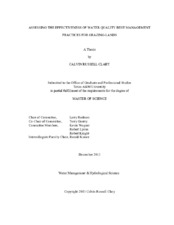| dc.description.abstract | Best management practices (BMPs) aim to reduce bacterial loading caused by grazing cattle. Relatively little is known about the effectiveness of alternative shade, alternative water, rip-rap, and prescribed grazing as potential BMPs. Prescribed grazing evaluated how stocking rate affected bacterial loading. E. coli concentrations in runoff samples were compared between plots with various stocking rates. GPS collars were used to determine how a shade pavilion, water source, or rip-rap effected cattle distribution within a stream and riparian pasture by comparing time cattle spent at a location before and after implementing the BMPs. While plots were stocked or within 14 days of being destocked, E. coli concentrations were significantly higher than destocked pastures. No significant differences were observed between E. coli concentrations in runoff from heavily stocked, moderately stocked, or non-grazed pastures when pastures had been destocked for greater than 14 days. On average, the shade structure reduced cattle's dependence on riparian shade by 30%. The alternative water BMP did not reduce the amount of time cattle spent within the riparian zone; however, the study was limited to one trial. Riparian rip-rap trials were inconclusive; however, preliminary rip-rap trials showed 20 to 40 cm diameter rip-rap was effective at modifying cattle trough preference.
Advances in microbial source tracking, specifically Bacteroides, have allowed better identification of bacterial sources. However, genetic variability within some Bacteroides sequences may undermine the accuracy of these molecular markers. Localized gene-copy curves were created from 12 bovine fecal samples from a single herd, and qPCR assays were used to determine if they better correlated Bacteroides and E. coli populations. Sequences were pyro-sequenced to see if mismatches occurred within primer/probe regions. Base-pair mismatches occurred, and affected qPCR efficiencies. Fecal pollution load estimations were overestimated by using sequences with more mismatches. Genetic diversity was observed within samples from all locations, and indicated genetic variability within Bacteroides populations occurs within a single location as much as between locations. Thus, creating standard curves for individual watersheds would not necessarily improve pollution load estimations. | en |


